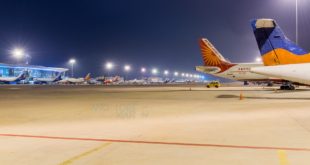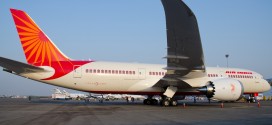India’s most successful airline Indigo continued to impress with its fourth quarter and full year earnings. A look at the numbers reveals how Indigo has managed its business.
Operational performance
For the year, IndiGo carried a total of 33.1 million passengers carried, a 31.5% increase as compared to the same period last year. During the year, IndiGo registered a 21.2% increase in ASKMs (Available seat Kilometer Millions) as a result of a 12.9% increase in the fleet and improved aircraft utilization of 12.2 hours a day. Indigo is flying more people to more places while doing so in a reliable manner which is consistent with their business model. Average aircraft utilization of 12.2 hours a day indicates adequate network “slack” being built in which is indicative of good planning. Despite the capacity increment, their load factor improved by 4.2% to 84% helped by lower fares (15% YOY) and overall market growth. The number of cities in network is now at 35 in Domestic market and 5 in International Market and reflects the core strategy of Indigo which is to connect all points in the network.
Their strategy to rule the market they enter by focusing on increased frequency has worked rather well for them; giving them price advantage over their rivals. In spite of declining yields it has managed to drive revenue increases via innovative methods, strong ancillary revenues and network growth. During the year, IndiGo’s average number of daily departures increased by 22.5% to around 648 departures a day.
Overall, the airline has seen profitable induction of capacity which is commendable especially as everyone, older airlines and the new entrants alike have been on a capacity infusion spree.
However, one must remain skeptical with regards to additional capacity induction given that the government is attempting to finalize the draft aviation policy including the point on the 5/20 rule. If and when 5 year rule is abolished, the market is likely to see an unprecedented capacity induction which can severely affect even the likes of IndiGo.
Financial performance
Indigo continues to have consistent operations, strong cash position, strong liquidity and an enviable balance sheet.
While results were driven by lower fuel prices and soaring demand, what Indigo has done extremely well is profitable induction of capacity. However, the fourth quarter results were below the market expectations and led to a 3.4% decline in its share price. For the quarter, the company reported an operating revenue of Rs 4,06.1 crores, a 5.4% increase as compared to the same period last year. While the passenger growth for the same period was 7.2%, it was partially offset by a 11.3% decline in yields (average revenue per passenger). Depressed yields led to a 25% decline in operating margins per passenger even as the operating cost per passenger went down by 7.4% in light of lower fuel cost and economies of scale. The company reported a net profit of Rs. 579 crores for the quarter and managed to grab 38.4% marketshare.
Despite less than expected fourth quarter results, the company reported its highest ever net profit of Rs 1,990 crore for FY16 (53% increase YOY). Their EBITDAR (Earnings Before Interest Tax Depreciation Amortization and Rentals) margin improved by 7.1% to an impressive 34.4%. EBITDAR margin reflects operational efficiency of a company and how much of the company earns after taking care of its operational costs excluding the aircraft lease rentals. It also allows for an apple-to-apple comparison between different companies with different asset acquisition structure (for e.g., while IndiGo leases all its aircraft, Jet Airways has bought some aircraft and leased others). IndiGo currently maintains the highest EBITDAR margin in the Indian aviation industry. EBIT (Earnings Before Interest and Tax) margin improved by 3.9% to 15%, mainly as a result of 10.1% reduction in operating CASK (Cost per Available Seat Kilometer).
With regards to the balance sheet, during the year, IndiGo has used the proceedings of the IPO partially to repay their long term debt and has reported a net reduction of Rs 638.5 crores in the same. It is to be noted that all of this debt is pertaining to acquisition of aircraft and there is no working capital related debt on IndiGo’s balance sheet. With the debt repayment there is a 24% reduction in interest cost per aircraft for the quarter ending March 2016, a significant reduction and cost advantage for the company. Strong operating performance and unused amount of the IPO proceedings have increased the company’s cash position to Rs 3,718.7 crores making it a virtually debt free company.
Interestingly Indigo has no stated dividend policy and dividends are approved in board meetings. This year a dividend of INR15 per share (excluding the interim pre-IPO dividend of Rs. 42.83 per share) was declared which will net promoters Rs. 465.7 crores.
The airline’s dollar denominated cost items such as maintenance cost, interest cost, and lease rental remained in check despite of a 2.6% strengthening of US Dollar compared to Indian Rupee. Given the airline’s history for unprecedented orders and getting attractive deals, it is likely to reap benefits from reduced maintenance cost, as benefits and competitive contracts with Pratt and Whitney kicks in with the subsequent deliveries of NEOs. Additionally, there will likely be delay payments from Pratt and Whitney. The airline is also in talks with CFM for the remaining fleet engines which will give them a strong negotiating position. Even though, the benefits may not be as much as expected given the lower fuel prices, cost efficient NEOs are still expected to contribute positively to the bottom-line.
Expansion costs
With a 12.9% increase in the year end fleet Indigo has been on an aggressive hiring spree. Additionally, during the IPO there was an 8% increase in ESOPs (Employee Stock Option Program); ESOPs are employee benefit plan which are intended to encourage employees to acquire stocks or ownership in the company where the company gives out stocks as part of the employee’s remuneration. Along with the effects of inflation it has resulted in 53% YoY increase in the employee expense. In a competitive market like India, employee retention is becoming a key factor and ESOPs are an integral part of the same. It was the management’s foresight to aggressively hire in light of the incoming aircraft. However, due to the delay in the deliveries of NEOs (the first delivery was towards the end of the quarter ending March 2016, as compared to the scheduled delivery at the end of the quarter ending December 2015).
Additionally, other cost related to expansion (increased total maintenance cost, lease rentals etc) are reflected in the CASK (excluding fuel) increase of 11.5% YOY. However, overall CASK has witnessed a 8.9% YOY decline. Indigo states that the CASK increase is driven by rupee depreciation, increase in employee benefit cost and excess staff
Other factors
As mentioned on the earnings call, the cooling down issue in the NEO engines continue to be a challenge due to which the fuel savings are coming in at 13% versus the target of 15% (this may actually work out to Indigo’s benefit depending on how they negotiate delay compensation). With the start time issues, as the NEO fleet increases, network impact will also grow which as of now can be managed with the buffers within the network.
Additionally, with the hiring spree expected to continue, employee and benefit costs are set to increase.
Indigo is likely to face challenge raking handsome profits as in the past with the Sale and Leaseback (SLB) transactions, given the decline in NEOs popularity in the face of declined oil prices. However, with the recovery seen in the oil prices, NEOs may yet turn out be as attractive an option as they were before the sharp decline in oil prices.
On the fleet financing side, with 35 aircraft already financed, the airline has mitigated the adverse effect of dip in popularity of A320 NEOs for another year and resultant increment in lease rentals (unpopularity of the NEOs with the leasing companies can drive up the rentals).
Conclusion
Overall it has been a great result. Yet there are a few items of caution. IndiGo is slated to induct 24 new aircraft in FY17, which is much more than its historical record. Given that this is the maximum induction till date, and competitors such as GoAir, Vistara and Air India are all inducting aircraft this year, profitable absorption of this capacity is likely to be an area of concern. It will be interesting to see IndiGo maintain the same profit records with oil prices recovery and significantly increased capacity in future which is likely to outpace the demand. While Indigo is doing a great job of managing the airline, the expectations are sky high and it will now likely have to manage expectations as well.
 Bangalore Aviation News, Reviews, Analysis and opinions of Indian Aviation
Bangalore Aviation News, Reviews, Analysis and opinions of Indian Aviation



very well written analysis. the author has covered several interesting angles in depth. enjoyed reading it a lot. thanks.
Any comparison of this qtr result compared with same qtr last year is irrelevant. Because at that time, it had capacity N, this time the capacity is N*. (N<N*)
Above all, at the end of the day we feel that in this business one does not get a 1% per month return on the investment. Is the business worth it?
Any comparison of this qtr result compared with same qtr last year is irrelevant. Because at that time, it had capacity N, this time the capacity is N*. (N<N*)
Above all, at the end of the day we feel that in this business one does not get a 1% per month return on the investment. Is the business worth it?